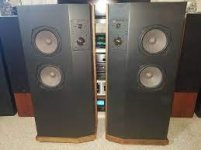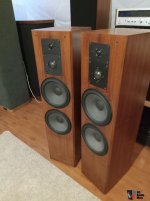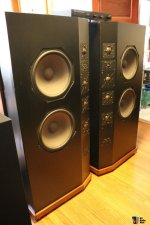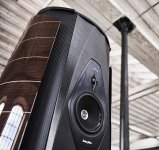Hi all,
To my knowledge, the narrower baffle will provide a better image of sound. However, there are some designs that are likely to be considered narrow baffles, despite the full-sized enclosures. For example, the old ADS speakers model LXX30 series; here I'll use the L1530 as an example.
As can be seen, the midrange and tweeter of the L1530s are mounted on a small baffle located at the edge of the cabinet.
I'd like to compare the cabinet shapes of the L1530 and L1590, as depicted in the attached.
1) IF EVERYTHING, including the drivers and crossovers, is the same, which model will give a better image of sound?
2) In my view, the L1590s perhaps give a better image, but how about if we change the L1530 to the flagship L2030? The L2030 has four midranges installed in a vertical array. Hence, could it compensate for the destroyed image and result in a better image than the L1590?
To my knowledge, the narrower baffle will provide a better image of sound. However, there are some designs that are likely to be considered narrow baffles, despite the full-sized enclosures. For example, the old ADS speakers model LXX30 series; here I'll use the L1530 as an example.
As can be seen, the midrange and tweeter of the L1530s are mounted on a small baffle located at the edge of the cabinet.
I'd like to compare the cabinet shapes of the L1530 and L1590, as depicted in the attached.
1) IF EVERYTHING, including the drivers and crossovers, is the same, which model will give a better image of sound?
2) In my view, the L1590s perhaps give a better image, but how about if we change the L1530 to the flagship L2030? The L2030 has four midranges installed in a vertical array. Hence, could it compensate for the destroyed image and result in a better image than the L1590?
Attachments
Diffraction off the edge of an enclosure creates a secondary wavefront, similar to the initial wavefront, but delayed and filtered. (Because the edges are a few centimeters from where the drivers are.)
Small baffles reduce that time delay, causing it to be perceived as (closer) to the initial wavefront
Big baffles increase the delay to a point where it may not be perceived as part of the initial wavefront
With a big enough roundover, I've heard big baffled speakers that sound like they're much smaller than they physically are. In cases like this, it helps to listen with the lights out, because seeing the speaker will give you cues that define the soundstage.
Small baffles reduce that time delay, causing it to be perceived as (closer) to the initial wavefront
Big baffles increase the delay to a point where it may not be perceived as part of the initial wavefront
With a big enough roundover, I've heard big baffled speakers that sound like they're much smaller than they physically are. In cases like this, it helps to listen with the lights out, because seeing the speaker will give you cues that define the soundstage.
It has to be related to the physical magnitude of the phenomenon, i.e. waves that have multiple frequencies ( ?!) that have the wavelenght ( expressed in cm or inches ) similar of the object it encounters, or when placed on a baffle, the speaker, it utilizes the space around to spread those waves ( integration ), so when the wave (impulse) leaves the surface the corner means diffraction, same when a wave encounters an object.
That's why for subwoofers ( or at least, for a spectrum covered by woofers usually ) it doesn't matter the shape- even internal damping in of no effect for VLFs, if you follow the external/internal(back wave) emission of a membrane
That's why for subwoofers ( or at least, for a spectrum covered by woofers usually ) it doesn't matter the shape- even internal damping in of no effect for VLFs, if you follow the external/internal(back wave) emission of a membrane
If you can make the choice extended to the thousand ( of thousands) of different speakers produced in the last 40 years, to limit the research2) In my view, the L1590s perhaps give a better image, but how about if we change the L1530 to the flagship L2030? The L2030 has four midranges installed in a vertical array. Hence, could it compensate for the destroyed image and result in a better image than the L1590?
OH! Acoustic Research! That was often mentioned when studying complex speaker systems!
Nowadays I don't see it mentioned anymore...🙁
The one with the lowest diffraction signature.
These work really well:
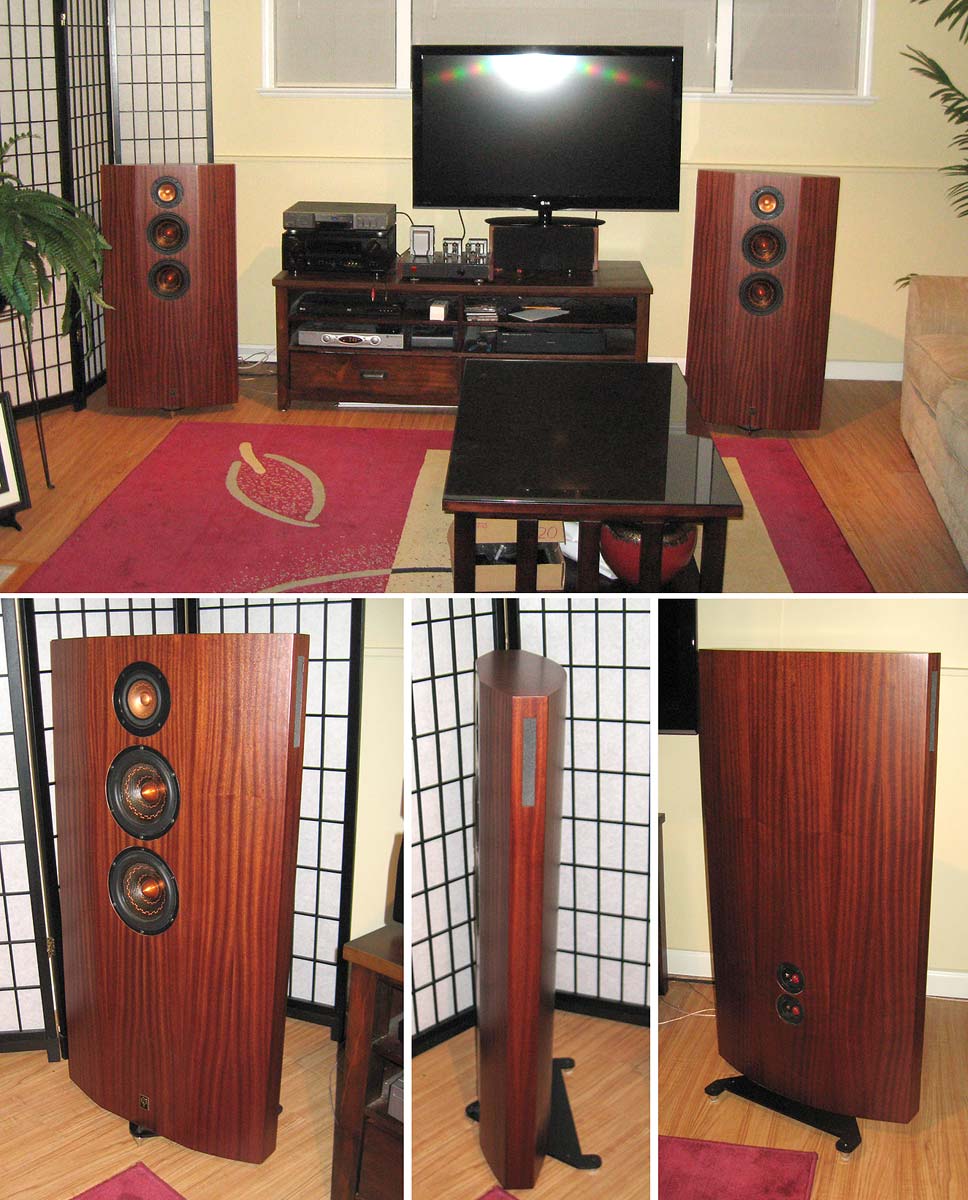
But so do these, the heavily chamfered trapezoid shape really works well in this resepect with a notably lower diffraction signature than teh same box in a more conventional shpae.
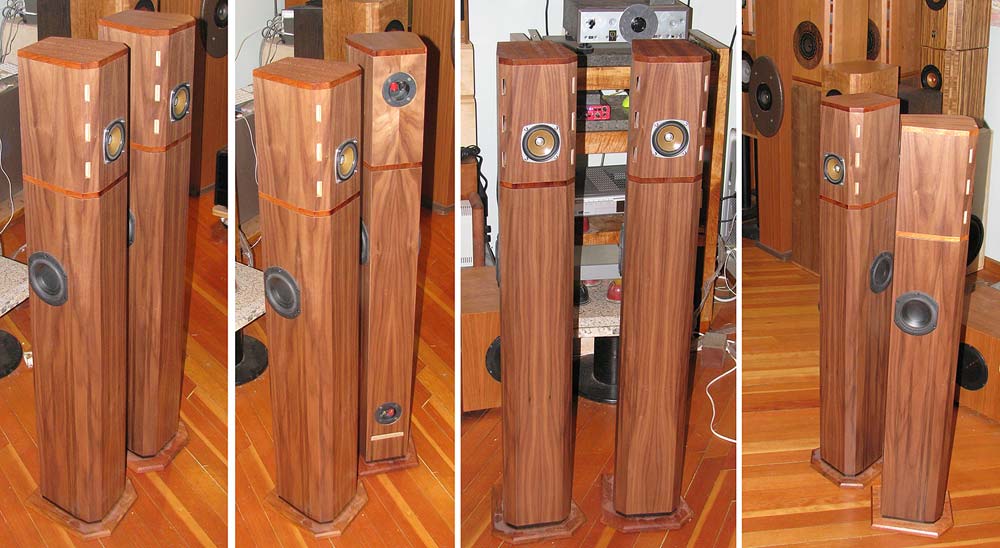
dave
These work really well:

But so do these, the heavily chamfered trapezoid shape really works well in this resepect with a notably lower diffraction signature than teh same box in a more conventional shpae.

dave
Hello,
the big heigth and width front baffles are good to the soundstage game (we realised the smoothness of the edges may be important as well to avoid sudden difraction than can be noticed by ears) , read at an introduction the STradivari loudspeaker for the poors on Troel gravsen site.
Here we had a more serious conversations about soundstage and immersion and focusing than can be different concepts. I remember a thread, but can not find it in the mass. Was in this same forum sub part.
The rule seems to be a constant off axis magnitude and a room that is not too much reflective or/and more focused off axis magnitude with horn/Wave guide abive the helmootz frequency where the room is rulling (often bellow circa 200 hz... grossly)
the big heigth and width front baffles are good to the soundstage game (we realised the smoothness of the edges may be important as well to avoid sudden difraction than can be noticed by ears) , read at an introduction the STradivari loudspeaker for the poors on Troel gravsen site.
Here we had a more serious conversations about soundstage and immersion and focusing than can be different concepts. I remember a thread, but can not find it in the mass. Was in this same forum sub part.
The rule seems to be a constant off axis magnitude and a room that is not too much reflective or/and more focused off axis magnitude with horn/Wave guide abive the helmootz frequency where the room is rulling (often bellow circa 200 hz... grossly)
Hi,
If having round-overs with 10 cm radius (4") on the front plate, I wondered if the external shape of tear dropes going to the back, gave a better imaging than the sides walls staying parrallel (but still with the same roundovers at the front as at the back of the cabinet ?
Any thougth ?
I know tear drop shape (B&W flagships for illustration) is one of the best to figth a little the baffle step (see Dickason book), but is it really better when having big radius like 10 cm already, so a smmoth transition already (talking about >300 hz).
I am not asking about internal volume but external shape about difraction behavior only, for instance see Sonus Faber Aida where the sides have such recess from the front to the back, even so the side are not touching the front baffle because there are vents (à la Onken) between the front plate and the rib sides : see picture.
If having round-overs with 10 cm radius (4") on the front plate, I wondered if the external shape of tear dropes going to the back, gave a better imaging than the sides walls staying parrallel (but still with the same roundovers at the front as at the back of the cabinet ?
Any thougth ?
I know tear drop shape (B&W flagships for illustration) is one of the best to figth a little the baffle step (see Dickason book), but is it really better when having big radius like 10 cm already, so a smmoth transition already (talking about >300 hz).
I am not asking about internal volume but external shape about difraction behavior only, for instance see Sonus Faber Aida where the sides have such recess from the front to the back, even so the side are not touching the front baffle because there are vents (à la Onken) between the front plate and the rib sides : see picture.
Attachments
Really wonder if those external ribs play a role due to their shape or are just here to suit for aesthic the core cabinet shape made for internal purpose only -internals modes )?
Seem constrained ply with a veener, what about vibrations, does they have a chance to sing ? I see the latteral vents as a big difraction behavior
Seem constrained ply with a veener, what about vibrations, does they have a chance to sing ? I see the latteral vents as a big difraction behavior
What is better imaging?🙂 Listen very close to speakers to hear proper image, void of too much room coloration. If you listen far away, like 3m away or further in a normal room with small speaker it probably does not matter too much what the edges are. Beyond critical distance brain does not separate direct sound and envelopment but hears just a single blob of sound coming form direction of speakers. The single perception contains coloration of the room and speaker, not sure any small things are audible here.
What is too far, or close enough? There seems to be quite distinct transition between the two at some distance from speakers, where direct sound to room sound ratio is sufficiently high so brain can lock in to the direct sound as Griesinger has found out.
Now, the better the speaker and room acoustics is, quite likely also the higher the DI is, the further away the audible critical distance is, possibly few meters out from speakers.
So, I speculate if you listen and like to listen beyond the critical distance, perhaps do not stress too much about diffraction and stuff. If you want to listen closer than critical distance for best image, then do what ever to make the speaker better acoustically and DI smoother, perhaps higher as well, say from 700Hz up, or why not all the way from schroeder frequency up. Good diffraction performance means very little secondary sound sources at least within listening window. This happens when flat baffle area is minimized, in other words smooth transition needs to start right beside the transducer. the teardrop shape does this, reduces edge diffraction secondary sound source and helps directivity. The shape adjusts how sound goes all around of the box as well as addresses back edge diffraction, which likely reduces secondary sounds on listening window again and perhaps has positive effect to DI overall. Still, what is audible and what is not, well, not sure. Very good speaker should consider everything and is best listened within the critical distance to hear the difference to a poorer design.
The speaker you attached is likely modified for aesthetics and to justify high price, it is piece of art and sound quality is of secondary matter. Although the judging from the image there is no reason the speaker did not sound good. But, I cannot think any reason why the extra side ribs would improve sound quality and I think they are just visual effect. Perhaps there is some acoustic effect as well.
What is too far, or close enough? There seems to be quite distinct transition between the two at some distance from speakers, where direct sound to room sound ratio is sufficiently high so brain can lock in to the direct sound as Griesinger has found out.
Now, the better the speaker and room acoustics is, quite likely also the higher the DI is, the further away the audible critical distance is, possibly few meters out from speakers.
So, I speculate if you listen and like to listen beyond the critical distance, perhaps do not stress too much about diffraction and stuff. If you want to listen closer than critical distance for best image, then do what ever to make the speaker better acoustically and DI smoother, perhaps higher as well, say from 700Hz up, or why not all the way from schroeder frequency up. Good diffraction performance means very little secondary sound sources at least within listening window. This happens when flat baffle area is minimized, in other words smooth transition needs to start right beside the transducer. the teardrop shape does this, reduces edge diffraction secondary sound source and helps directivity. The shape adjusts how sound goes all around of the box as well as addresses back edge diffraction, which likely reduces secondary sounds on listening window again and perhaps has positive effect to DI overall. Still, what is audible and what is not, well, not sure. Very good speaker should consider everything and is best listened within the critical distance to hear the difference to a poorer design.
The speaker you attached is likely modified for aesthetics and to justify high price, it is piece of art and sound quality is of secondary matter. Although the judging from the image there is no reason the speaker did not sound good. But, I cannot think any reason why the extra side ribs would improve sound quality and I think they are just visual effect. Perhaps there is some acoustic effect as well.
Last edited:
Any thougth ?
Like most things with speakers it depends on your objectives. Soffit mounting is essentially free of secondary sources from diffraction off edges and yet a fair few claim the imaging from various small speakers is superior. Placing a book on top of such a speaker will likely change it's imaging. So what is going on and how does it relate to what you might want for your own designs?
Thanks fellows,
I typically listen to 3 to 3.5 meters... bouncing european living room with furnitures.
I typically listen to 3 to 3.5 meters... bouncing european living room with furnitures.
Yeah that is practical listening distance for me as well, normal living room and speakers are where they fit and sofa at another location. But, the sound opens up if I get to about 2.2m from speakers, distance from ear to speaker. And this is quite high directivity speaker, cardioid mid and waveguide so its 6-10db from 300Hz to 20kHz. Your speakers in your room, the distance could be shorter or longer. I suggest try and walk on the centerline between speakers and try to listen where you hear the stereo image shift. I have found it most audible like so: Put mono noise, or spoken word, same signal to both speakers for maximally good phantom center. Now listen size and clarity of the phantom center and move back and forth on the center line between speakers. At some point you should hear transition, when you are close enough to speakers the phantom center size gets quite small and clarity seems to increase, its very well defined. When you are beyond the transition the phantom center is just a hazy ball of sound some where between speakers, quite big, not very clear, in comparison. If you do not hear it try to maximize direct sound somewhere around 1-2m distance, put speakers only 2m apart or so, toe speakers in 30deg or so.
If you do find the transition, note the distance from ear to speaker. Try with music if you like it. Adjust stereo triangle size and toe-in to your liking.
Some people seem to like the close sound, while some like the far better. Certainly the far sound ought to be more forgiving to speaker issues, while the close sound is more forgiving to room issues I think.
Certainly the close sound is great in my opinion, 3D and as huge as I want depending on the setup, local room more or less disappears. Beyond the critical distance sound seems to be more far away in front of me and 2D in comparison. Its a bit hazy sound and nice for some recordings like Jazz where drums are on other speaker and soloist on another, local room is mixed in.
Some studio work is just beutifull on the close listening, really nice sound, nice huge stereo image and clarity, while some might be bit annoying even if too radical panning. I do not listen classical, should try some day to find out to see if there is preference between the two presentations.
If nothing else this listening experiment should help to learn how to listen the stereo image and what is effect of your room and so on, hopefully its a useful thing and you get better sound. I bet many setups would benefit this and adjustment afterwards. I think this helps get best out of any system, no need to purchase new amplifier and so on, cables 🙂
If you do find the transition, note the distance from ear to speaker. Try with music if you like it. Adjust stereo triangle size and toe-in to your liking.
Some people seem to like the close sound, while some like the far better. Certainly the far sound ought to be more forgiving to speaker issues, while the close sound is more forgiving to room issues I think.
Certainly the close sound is great in my opinion, 3D and as huge as I want depending on the setup, local room more or less disappears. Beyond the critical distance sound seems to be more far away in front of me and 2D in comparison. Its a bit hazy sound and nice for some recordings like Jazz where drums are on other speaker and soloist on another, local room is mixed in.
Some studio work is just beutifull on the close listening, really nice sound, nice huge stereo image and clarity, while some might be bit annoying even if too radical panning. I do not listen classical, should try some day to find out to see if there is preference between the two presentations.
If nothing else this listening experiment should help to learn how to listen the stereo image and what is effect of your room and so on, hopefully its a useful thing and you get better sound. I bet many setups would benefit this and adjustment afterwards. I think this helps get best out of any system, no need to purchase new amplifier and so on, cables 🙂
Last edited:
At least in my case the ribs should be here just to smooth difraction if I decide to use them as the internal volume and front plate need only 16 cm width at minima if a square.
So with external ribs I found they add 10 cm on each side. So 36 cm not flat vs 15 cm flat for the mid cabinet... Bass to mid bass stay 36 to 38 cm width cause 12" driver.
If the ribs touch the front plate then the larger width migth reduce a little the baffle step or at least makes it bandwidth happens lower in frequency
So with external ribs I found they add 10 cm on each side. So 36 cm not flat vs 15 cm flat for the mid cabinet... Bass to mid bass stay 36 to 38 cm width cause 12" driver.
If the ribs touch the front plate then the larger width migth reduce a little the baffle step or at least makes it bandwidth happens lower in frequency
Last edited:
Its as much of aesthetics. I would build it modular, as small boxes/structures as possible (not much bigger than the transducer) for easy build and low acoustic interference. Easy to measure, easy to lift, easy to experiment, least problems on passband. But might look quite ugly to some 😀 also, I do not know how this kind of speaker works with passive xo, but if you have DSP no problem.
Have fun!🙂
Have fun!🙂
How far away were you listening? acoustics of the room, and listening distance and positioning make huge difference. Perhaps amplifier does too, but I suspect differences with modern electronics spatially are only audible if you are closer than the audible critical distance. Or, if there is something terribly wrong. Perhaps the speakers have tighter tolerance between their frequency responses than some other specimen you compare to?
Multiple things all interplaying, like with everything else loudspeakers 🙂
Multiple things all interplaying, like with everything else loudspeakers 🙂
It was just a demo in a hifi store listening room, so-so room treatment, about 2.5m listening distance, on nothing special Target stands. Source was I think an AVI Laboratory cd player and amp was the old style ATC SIA2-150 (class A preamp and class AB power stage). The ATC amp also gave a massive soundstage to some Dynaudio Audience speakers that I also auditioned. When the amp was changed between an Arcam and a Naim and a Primare, the soundstage shrunk noticeably, so this all amps (should) sound the same is bullcrap.
The best imaging speakers I've ever heard (like freaky big and wide soundstage) were the original Acoustic Energy AE1s, but I'm still not convinced it's only because of their small size.
Was the imaging accurate in the sense of what was in the recording or was it enhanced? Small speakers with flat baffles and sharp edges are going to have significant diffraction off the close edges and so cannot be expected to image accurately. However they do seem to push the imaging about significantly. A look at a typical HRTF and how the edge diffraction is likely to modify it may be of relevance.
- Home
- Loudspeakers
- Multi-Way
- Which shape of cabinet gives a better image?
